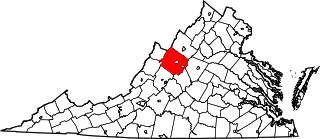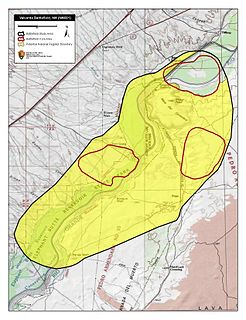
The Battle of Palo Alto was the first major battle of the Mexican–American War and was fought on May 8, 1846, on disputed ground five miles (8 km) from the modern-day city of Brownsville, Texas. A force of some 3,700 Mexican troops – most of the Army of The North – led by General Mariano Arista engaged a force of approximately 2,300 United States troops – the Army of Occupation led by General Zachary Taylor.

The Battle of Piedmont was fought June 5, 1864, in the village of Piedmont, Augusta County, Virginia. Union Maj. Gen. David Hunter engaged Confederates under Brig. Gen. William E. "Grumble" Jones north of Piedmont. After severe fighting, Jones was killed and the Confederates were routed. Hunter occupied Staunton on June 6 and soon began to advance on Lynchburg, destroying military stores and public property in his wake.

The Battle of Cloyd's Mountain was a Union victory in western Virginia on May 9, 1864 that allowed the Union forces to destroy the last line connecting Tennessee to Virginia.
The Battle of Waynesboro was fought on March 2, 1865, at Waynesboro in Augusta County, Virginia, during the American Civil War. It was the final battle for Confederate Lt. Gen. Jubal Early, whose force was destroyed.
The Third Battle of Murfreesboro, also known as Wilkinson Pike or the Cedars, was fought December 5–7, 1864, in Rutherford County, Tennessee, as part of the Franklin-Nashville Campaign of the American Civil War.

The Battle of Haw's Shop or Enon Church was fought on May 28, 1864, in Hanover County, Virginia, as part of Union Lt. Gen. Ulysses S. Grant's Overland Campaign against Confederate Gen. Robert E. Lee's Army of Northern Virginia during the American Civil War.

The Battle of Valverde, also known as the Battle of Valverde Ford, was fought from February 20 to 21, 1862, near the town of Val Verde at a ford of the Rio Grande in Union-held New Mexico Territory, in what is today the state of New Mexico. It was a major Confederate success in the New Mexico Campaign of the American Civil War. The belligerents were Confederate cavalry from Texas and several companies of Arizona militia versus U.S. Army regulars and Union volunteers from northern New Mexico Territory and the Colorado Territory.

The Army of New Mexico, also known as the Sibley Brigade, was a small Confederate field army in the American Civil War. It operated in Confederate Arizona and New Mexico Territory during the New Mexico Campaign in late 1861 and early 1862, before it was transferred to Louisiana. At first the force was tasked with securing Confederate Arizona's forts, most of which were still in Union hands. John R. Baylor had already established the Confederate Territory of Arizona after the First Battle of Mesilla in 1861. Now the goal was to capture the remaining U.S. held forts in Confederate Arizona and to invade New Mexico Territory. The army also hoped to capture the mines of Colorado and California, to secure gold and silver supplies to finance the Confederate war effort. Ultimately, the Confederate plans were thwarted at the Battle of Glorieta Pass.

The Battle of Pleasant Hill occurred on 9 April 1864 and formed part of the Red River Campaign during the American Civil War when Union forces aimed to occupy the Louisiana state capital, Shreveport.
The Battle of Fort Bisland was fought in the American Civil War between Union Major General Nathaniel P. Banks against Confederate Major General Richard Taylor during Banks' operations against the Bayou Teche region in southern Louisiana.

The Battle of Irish Bend, also known as Nerson's Woods or Franklin, was a battle in the American Civil War. It was fought between Union Major General Nathaniel Prentice Banks against Confederate Major General Richard Taylor during Banks's operations against the Bayou Teche region near Franklin, the seat of St. Mary Parish in southern Louisiana.

Walker's Greyhounds was the popular name for a division of the Confederate States Army under Major-General John George Walker, composed exclusively of units from Texas. It fought in the Western Theater and the Trans-Mississippi Department, gaining its nickname because the men were able to move long distances rapidly on foot.

Arthur Pendleton Bagby Jr. was an American lawyer, editor, and Confederate States Army colonel during the American Civil War. Confederate General E. Kirby Smith, commander of the Trans-Mississippi Department assigned Bagby to duty as a brigadier general on April 13, 1864, to date from March 17, 1864, and as a major general on May 16, 1865. These extra-legal appointments were not made official by appointments of Bagby to general officer grade by Confederate President Jefferson Davis or by confirmation by the Confederate Senate.
The following Confederate States Army units and commanders fought in the Battle of Spotsylvania Court House of the American Civil War. The Union order of battle is listed separately. Order of battle compiled from the army organization May 7–12, 1864, army organization May 13–25, 1864, the army organization during the Campaign and the reports.

Alfred Gibbs was a career officer in the United States Army who served as a brigadier general in the Union Army during the American Civil War.

The 6th Alabama Cavalry Regiment was a cavalry unit of the Confederate States Army during the American Civil War.

The 9th Louisiana Infantry Regiment or Louisiana Tigers was the common nickname for certain infantry troops from the state of Louisiana in the Confederate States Army during the American Civil War. Originally applied to a specific company, the nickname expanded to a battalion, then to a brigade, and eventually to all Louisiana troops within the Army of Northern Virginia. Although the exact composition of the Louisiana Tigers changed as the war progressed, they developed a reputation as fearless, hard-fighting shock troops.
The 39th Arkansas Infantry Regiment or Cocke's Arkansas Infantry Regiment was an infantry formation of the Confederate States Army during the American Civil War, and was successively commanded by Colonels Albert W. Johnson, A. T. Hawthorn, John B. Cocke, and Lieutenant-Colonel Cadwallader Polk.

The 4th Arkansas Field Battery (1862–1865) was a Confederate States Army artillery battery during the American Civil War. The battery spent its entire existence in the Department of the Trans-Mississippi, including time in the Indian Territory. Late in the war the battery supported operations in Louisiana. Also known as: Desha County Artillery and West's Battery.

The 16th Texas Cavalry Regiment was a unit of mounted volunteers from Texas that fought in the Confederate States Army during the American Civil War. The regiment was recruited in early 1862 and mustered into Confederate service in April 1862. The unit fought as cavalry at the Battle of Cotton Plant but it was dismounted in the summer of 1862. The 16th Cavalry served as infantry in Walker's Texas Division for the remainder of the war. The regiment fought at Milliken's Bend, Mansfield, Pleasant Hill, and Jenkins' Ferry. The unit marched to Texas in early 1865 and disbanded in May 1865.














